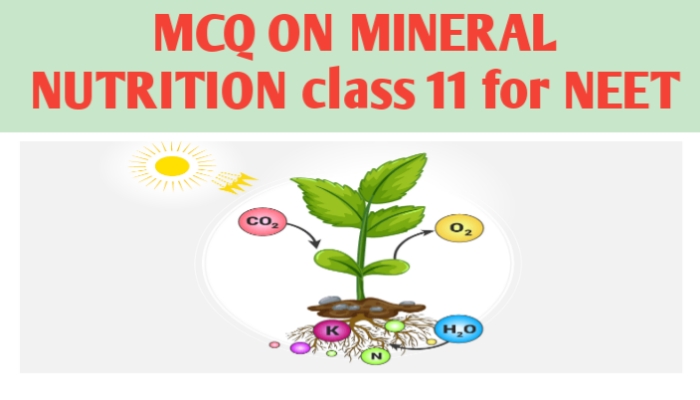MCQ ON MINERAL NUTRITION class 11 for NEET | MINERAL NUTRITION class 11 MCQ | MINERAL NUTRITION with Answer | Check the below NCERT MCQ question for class 11 Biology chapter 11 based on the MINERAL NUTRITION with Answers.
MCQ on MINERAL NUTRITION class 11 Biology with answers were prepared based on the latest pattern.We have provided class 11 Biology MCQs questions on MINERAL NUTRITION with Answers to help students understand the concept very well.

MCQ ON MINERAL NUTRITION class 11 for NEET
MCQ MINERAL NUTRITION is useful for NEET / CSIR / UGC / CBSE / ICSE / AIIMS / EXAM / AFMC EXAM / STATE LEVEL MEDICAL EXAM 2022-23
Introduction:-
The basic needs of all living organisms are essentially the same.They require macromolecules , such as carbohydrates , proteins and fats , and water and minerals for their growth and development. Most of the minerals present in soil can enter plants through roots . The technique of growing plants in a nutrient solution is known as hydroponics.
MCQ ON MINERAL NUTRITION class 11 for NEET
1. The technique of growing plants in a nutrient solution is known as
(a) osmosis
(b) diffusion
(c) translocation
(d) hydroponics
Ans (d) hydroponics
2. Essential elements as components of biomolecules and hence structural elements of cells.
(a) carbon, hydrogen, oxygen and nitrogen
(b) magnesium and phosphorus
(c) potassium and magnesium
(d) carbon, hydrogen , oxygen and phosphorus
Ans. (a) carbon, hydrogen , oxygen and nitrogen
3. Mineral plays an important role in the opening and closing of stomata.
(a) magnesium
(b) potassium
(c) nitrogen
(d) none
Ans. (b) potassium
4. The essential nutrient elements required by the plants in the greatest amount
(a) potassium
(b) oxygen
(c) carbon
(d) nitrogen
Ans.(d) nitrogen
5.The nutrient element , during cell division it is used in the synthesis of cell wall , particularly as calcium pectate in the middle lamellae.
(a) calcium
(b) magnesium
(c) nitrogen
(d) all the above
Ans.(a) calcium
6. The nutrient element constituent of the ring structure of chlorophyll and helps to maintain the ribosome structure.
(a) sulphur
(b) calcium
(c) magnesium
(d) phosphorus
Ans.(c) magnesium
ALSO READ:-
● YOU CAN WATCH BIOLOGY SIR Youtube channel
7. The mineral present in amino acids cysteine and methionine.
(a) sulphur
(b) nitrogen
(c) calcium
(d) iron
Ans.(a) sulphur
8. The nutrient mineral important constituent of proteins involved in the transfer of electrons like ferredoxin and cytochromes.
(a) sulphur
(b) magnesium
(c) calcium
(d) iron
Ans.(d) iron
9. The nutrient mineral needed in the synthesis of auxin
(a) manganese
(b) zinc
(c) copper
(d) boron
Ans. (b) zinc
10.The nutrient mineral helps in pollen germination , cell elongation.
(a) zinc
(b) copper
(c) boron
(d) chlorine
Ans. (c) boron
11. The nutrient mineral essential for the water – splitting reaction in photosynthesis
(a) chlorine
(b) boron
(c) copper
(d) molybdenum
Ans.(a) chlorine
12. The enzyme … is highly sensitive to the molecular oxygen , it requires anaerobic conditions.
(a) nitrogenase
(b) dehydrogenase
(c) hydrolase
(d) All the above
Ans.(a) nitrogenase
13. The cyanobacteria which is free living nitrogen fixers.
(a) anabaena
(b) nostoc
(c) both a and b
(d) rhizobium
Ans. (c) both a and b
14. The nodule contains all the necessary biochemical components such as enzyme
(a) nitrogenase
(b) leghaemiglobin
(c) both a and b
(d) none of above
Ans.(c) both a and b
15. The nodule have adaptions that ensure that the enzyme is protected from oxygen .To protect , the nitrogenase enzyme nodule contains an oxygen scavenger called
(a) dehydrogenase
(b) leg-haemoglobin
(c) hydrolase
(d) all the above
Ans. (b) leg-haemoglobin
16.The enzyme , nitrogenase which is capable of nitrogen reduction is present exclusively in prokaryotes .Such microbes are called
(a) N2 – fixers
(b) Nodule formation
(c) imbitition
(d) active transport
Ans.(a) N2- fixers
17. The free living nitrogen fixing aerobic microbes which is anaerobic
(a) azotobacter
(b) beijernickia
(c) rhodospirillum
(d) both a and c
Ans.(c) rhodospirillum
18. The enzyme nitrogenase is a …,……. protein and catalyses the conversion of atmospheric nitrogen to ammonia.
(a) Mo – Fe protein
(b) N – Cl protein
(c) Na – K protein
(d) All the above
And.(a) Mo – Fe protein
19. The process of conversion of nitrogen (N2) to ammonia is termed as
(a) nitrogen – fixation
(b) N2- fixers
(c) nitrification
(d) All the above
Ans. (a) nitrogen – fixation
20. Ammonia is first oxidised to nitrite by the bacteria Nitrosomanas and nitrococcus .The nitrite is further oxidised to nitrate with the help of the bacterium nitrobacter .These steps are called
(a) denitrification
(b) nitrification
(c) chemoauutotrophs
(d) all the above
Ans.(b) nitrification







Leave a Comment